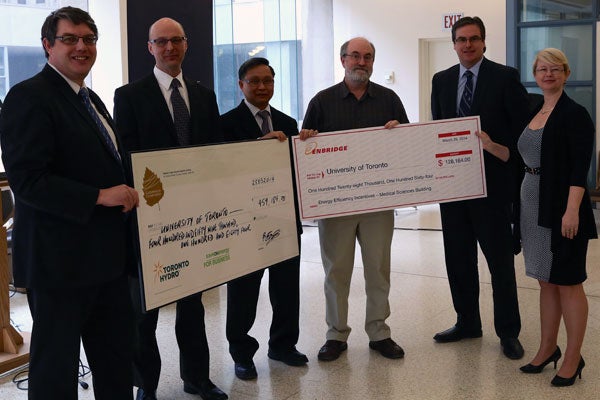
Fueling research while saving energy
Published: March 26, 2014
From early-morning classes to late-night lab work, the University of Toronto’s Medical Sciences Building (MSB) is a bustling hub for thousands of students, scientists and academic leaders. Its extensive, 24-hour wet labs — where researchers handle chemicals, drugs and biological matter — and plethora of offices and classrooms mean it requires more energy than any other campus building to run efficiently and safely.
But thanks to an innovative energy reduction initiative, supported by both U of T’s Facilities and Services Department and the Faculty of Medicine, the MSB is drastically reducing its annual energy consumption and saving more than $1 million annually.
“With a campus this size and complexity, coupled with the funding challenges all Ontario universities are experiencing and the impact of increasing energy costs, projects like these that simultaneously increase the efficiency of campus operations and reduce our environmental footprint become increasingly more important,” says Ron Swail, U of T’s assistant vice-president of facilities and services, who likens the operation of the St. George Campus to a city of 80,000 people (approximately the size of Victoria, B.C.) with massive buildings and distinct energy demands. “The simple payback on this project is less than a year, which is phenomenal -- the best I’ve ever seen on a project of this magnitude.”
Conceived and spearheaded by Chun Lee, U of T’s manager of mechanical operations and maintenance, the University installed cutting-edge technology to dramatically improve the building's mechanical systems. This included installation of variable speed drive fan technology, enhanced building automation, and wireless room level thermostatic controls, so air flow and temperature can now be automatically adjusted based on the building’s occupancy needs.
“Before, fresh cooled or heated air was supplied to empty rooms overnight. The new system delivers air based on time of day and the type of work performed,” says Heather Taylor, director of facilities management and space planning in the Faculty of Medicine.
The $1.5 million initiative included $587,000 in incentives from Toronto Hydro and Enbridge Gas, bringing the net costof the project to $913,000. Ceremonial cheques from Enbridge and Toronto Hydro were presented to the University Tuesday in a brief ceremony.
The primary project team consisted of: Ron Swail, Chun Lee, Attila Keszei, Heather Taylor, Tim Neff, Tony Kern, Bruce Dodds, Dieter Pfeiffer, Paul Leitch, Samiddha Aryasinghe, Clinton Watkis, Artur Syrek, Radu Ciotirca and Ivanna MacIsaac.
U of T students, faculty and staff who are interested in reducing the University's environmental footprint can visit the Facilities and Services Sustainability Office's website and submit ideas to the Energy & Resouce Management Fund.
Sustainability is a core value of U of T Facilities and Services. Through creative energy-saving solutions, here’s what U of T has achieved over the past 40 years:
- More than 79 billion litres of water saved
- More than 1 million tonnes of greenhouse gas avoided
- More than $200 million in utilities cost savings
- 72 per cent of St. George campus’ total waste is recycled — one of the highest diversion rates of any North American university - more than 250,000 trees saved through paper product recycling alone
U of T students, faculty and staff who are interested in reducing the university’s environmental footprint can visit the Facilities and Services Sustainability Office’s website and submit ideas to the Energy & Resource Management Fund.



